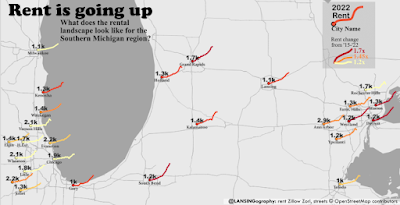To the surprise of absolutely nobody, rent increases. Population is increasing, people need a place to stay, and in most areas of the United States, housing and density has not matched the rate of population growth. Many locations already had more demand for housing stock than existed in supply. Simple supply and demand can explain some of the rent increases. When there is great demand for something, suppliers can leverage that demand into higher prices, especially in the case of something that is a need, like housing. It's hard to walk away from a price if you can't find housing somewhere else.
However, in the last decade, rents have not increased evenly. Some areas have more housing stock thus mitigating demand; some places are more or less popular than others.
Lansing's metropolitan area (Lansing, East Lansing, Dewitt, Holt) has seen a 57% raise in rents from June 2015 to December 2022. That is above average in Michigan, but it's not even the place with the fastest growing rents: Grand Rapids and Detroit have higher rents and rents that are increasing more rapidly.
Zillow, the real estate website, monitors the rent that appears in its rental database, but it also weights it based on the types of rental properties in the US Census. Then it takes a three-month rolling average, and creates an index based on the 40th to 60th percentile rents, to exclude very high or very low outliers. (It's a bit complicated, you can read the methodology here.)
Currently, Zillow estimated that the mean rent in Greater Lansing is around $1,100. Here is a quick visualization of what that rent curves look like across Southern Michigan:

No comments:
Post a Comment